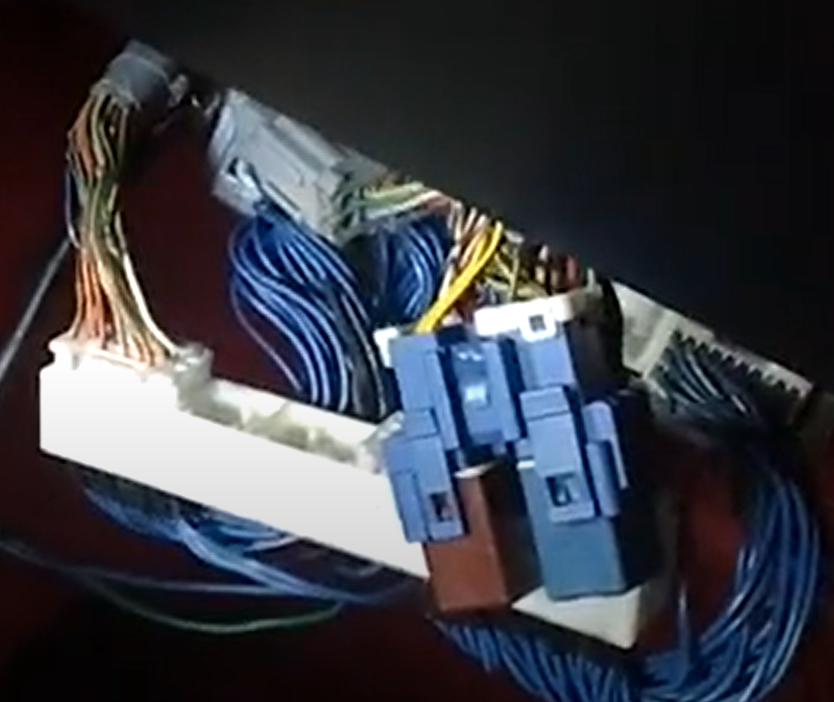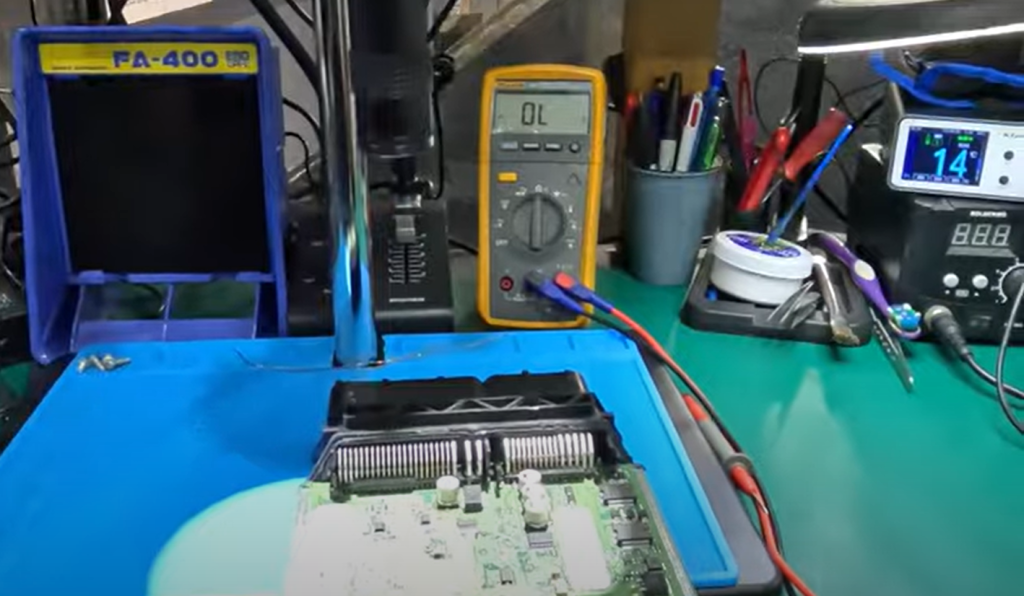When a car won’t start, the problem might be a lack of power from the Engine Control Module (ECM) to the fuel pump relay. This issue can stop the fuel pump from working, leaving the engine without the fuel it needs to run. A car with no power from the ECM to the fuel pump relay won’t start because no fuel is reaching the engine.
Several things can cause this problem. The ECM itself might be faulty, or there could be a problem with the wiring between the ECM and the fuel pump relay. Sometimes, a bad fuse or a problem with the fuel pump relay can also be to blame. Finding the exact cause often requires testing different parts of the system.
Fixing this issue usually involves checking the wiring, fuses, and relays. If these are all okay, the ECM might need to be looked at by a mechanic. In some cases, replacing the fuel pump relay or the ECM might be needed to get the car running again.
Key Takeaways
- No power from the ECM to the fuel pump relay stops the car from starting
- The problem can be caused by faulty wiring, bad fuses, a broken relay, or ECM issues
- Fixing the issue often involves testing different parts and may require professional help
Understanding ECUs and Fuel Pump Relays
The Engine Control Unit (ECU) and fuel pump relay work together to manage fuel delivery in modern vehicles. These components play crucial roles in ensuring the engine receives the right amount of fuel at the right time.
Basics of Engine Control Units
The Engine Control Unit, also called the Engine Control Module (ECM), is the brain of a vehicle’s engine management system. It uses data from various sensors to control engine functions.
The ECU monitors factors like engine speed, temperature, and air intake. It then adjusts fuel injection, ignition timing, and other systems for optimal performance.
ECUs send signals to many components, including the fuel pump relay. This communication ensures the fuel system operates correctly.
Modern ECUs can store diagnostic codes. These codes help mechanics identify issues when something goes wrong with the engine or related systems.
Role of the Fuel Pump Relay

The fuel pump relay acts as a switch between the ECU and the fuel pump. It controls when the fuel pump receives power and starts working.
When the ignition is turned on, the ECU sends a signal to the fuel pump relay. This closes the relay switch, allowing power to flow to the fuel pump.
The relay protects the fuel pump from electrical overload. It also helps conserve energy by only powering the pump when needed.
If the fuel pump relay fails, the pump won’t receive power. This can lead to starting problems or engine stalling. Regular testing of the relay can help prevent unexpected breakdowns.
Diagnostic Approach to Power Issues
When a fuel pump relay isn’t getting power from the ECM, a systematic diagnostic approach is crucial. This involves carefully assessing the situation and methodically checking electrical connections to pinpoint the root cause.
Initial Assessment and Safety Precautions
Start by turning the key to the “on” position without starting the engine. Listen for the fuel pump priming sound. If there’s no sound, it suggests a potential power issue.
Next, locate the fuel pump relay in the fuse box. Check if it’s seated properly. Remove and inspect it for any visible damage or corrosion.
Safety is paramount. Disconnect the battery before working on electrical components. This prevents short circuits and potential injury.
Use a multimeter to test the battery voltage. A weak battery can cause relay issues. The reading should be between 12.4 and 12.7 volts.
Troubleshooting Electrical Connections
Begin by checking the ECM-B fuse. A blown fuse can prevent power from reaching the relay. Replace if necessary.
Inspect the wiring harness connected to the fuel pump relay. Look for signs of damage, fraying, or loose connections. Repair or replace as needed.
Use a multimeter to test for voltage at the relay socket. With the key in the “on” position, you should see battery voltage on the power input pin.
If no voltage is present, trace the wiring back to the ECM. A faulty ECM can prevent power from reaching the relay. In this case, further testing or professional diagnosis may be required.
Common Causes for Power Disruption
When a fuel pump relay doesn’t get power from the ECM, several issues can be responsible. These problems often stem from electrical components or connections in the vehicle. Let’s look at the main culprits.
Faulty Wiring or Connectors
Damaged or loose wiring can interrupt power flow to the fuel pump relay. Frayed wires or corroded connectors may cause intermittent or complete power loss. Check all wires and connections between the ECM and fuel pump relay.
Look for signs of wear, such as exposed copper or visible damage to the insulation. Ensure all connectors are clean, tight, and free from corrosion.
Vibration from driving can loosen connections over time. Gently wiggle wires and connectors to test for loose connections. If any move easily, they may need tightening or replacement.
ECM Power Supply Problems
The ECM needs a stable power supply to function correctly. If it’s not getting enough power, it can’t send the signal to the fuel pump relay.
Check the ECM’s power and ground connections. Look for loose, corroded, or damaged wires. Clean any dirty connections and replace any damaged wires.
A weak or failing battery can also cause ECM power issues. Test the battery voltage and replace it if it’s below 12 volts.
Alternator problems can lead to insufficient power for the ECM. If the alternator isn’t charging the battery properly, the ECM may not get enough power to operate correctly.
Failed Relay or Fuse
A blown fuse or faulty relay can prevent power from reaching the fuel pump. Check the fuse box for any blown fuses related to the fuel pump or ECM.
To test a relay, listen for a clicking sound when the key is turned to the “on” position. If you don’t hear a click, the relay may be faulty.
You can also swap the fuel pump relay with another identical relay in the fuse box. If the fuel pump works with the swapped relay, the original relay was likely bad.
Some relays can be tested with a multimeter. Check the resistance between specific pins to determine if the relay is functioning correctly.
Repair and Replacement Procedures
Fixing issues with the ECM and fuel pump relay often involves careful inspection and replacement of faulty components. Proper diagnosis is key before starting any repair work.
Relay Replacement Guidelines
To replace a faulty fuel pump relay, first locate the relay box. It’s usually under the hood or dashboard. Identify the correct relay using the vehicle manual. Carefully remove the old relay by pulling it straight out.
Check the new relay matches the old one exactly. Insert the new relay firmly into the socket. Make sure it’s seated properly. Test the fuel pump by turning the key to “On” without starting the engine. You should hear the pump run briefly.
If the new relay doesn’t fix the issue, further testing may be needed. This could include checking fuses, wiring, or the ECM itself.
ECM Inspection and Servicing

ECM problems can cause relay power issues. Start by checking ECM connections. Look for loose, corroded, or damaged wires. Clean dirty connections with electrical contact cleaner.
Use a multimeter to test ECM output voltages. Refer to your vehicle’s service manual for correct voltage readings. If voltages are off, the ECM may need repair or replacement.
Some ECM issues can be fixed by updating its software. This requires special equipment at a repair shop. If the ECM is faulty, replacement is often the best option. ECM replacement can be costly, ranging from $500 to $2000 depending on the vehicle.
Preventive Measures and Best Practices
Taking proactive steps can help avoid issues with the ECM and fuel pump relay. Regular maintenance and using quality components are key to keeping your vehicle running smoothly.
Regular Maintenance Tips
Check your vehicle’s fuses regularly. Bad fuses can prevent power from reaching the fuel pump relay. Replace any blown fuses immediately.
Clean the battery terminals and connections. Corroded or loose connections can disrupt power flow to the ECM and fuel pump relay.
Inspect wiring harnesses for signs of wear or damage. Replace any frayed or exposed wires to prevent short circuits.
Test the fuel pump relay periodically. A simple multimeter check can reveal potential issues before they cause a breakdown.
Have the ECM diagnosed during routine service visits. Early detection of ECM problems can prevent fuel pump relay failures.
Upgrading Component Quality
Install a high-quality fuel pump relay. Premium relays often have better durability and performance than budget options.
Consider upgrading to a more robust ECM if frequent issues occur. Some aftermarket ECMs offer improved reliability and features.
Use OEM or high-grade replacement parts for the fuel system. Quality components can reduce the risk of relay and pump failures.
Invest in a fuel pressure gauge. This tool helps monitor fuel system performance and can alert drivers to potential relay issues.
Install a fuel pump shut-off switch. This safety feature can prevent fuel spillage in case of an accident, protecting the ECM and relay system.
Frequently Asked Questions
ECM and fuel pump relay issues can be complex. Common problems include faulty connections, sensor malfunctions, and electrical failures. Proper diagnosis and repair procedures are key to resolving these issues.
What could cause the ECM to fail in supplying power to the fuel pump relay?
Several factors can cause an ECM to fail in powering the fuel pump relay. A damaged ECM is a primary culprit. Corroded or loose wiring connections between the ECM and relay can also interrupt power flow.
Faulty sensors that feed data to the ECM may cause it to withhold power. In some cases, a blown fuse in the ECM circuit can prevent power transmission to the relay.
How can I diagnose issues with fuel pump relay connectivity in specific car models like Toyota or Chevy?
Diagnosis methods vary slightly between car brands. For Toyota vehicles, checking the EFI fuse and inspecting the fuel pump relay are good starting points.
In Chevy models, testing the fuel pump relay and examining the wiring harness for damage are typical first steps. Both brands often benefit from using a diagnostic scanner to check for error codes related to the fuel system.
What are the steps to troubleshoot when there’s no power going from the ECM to the fuel pump relay?
Start by checking the fuses related to the fuel system and ECM. Next, test the fuel pump relay for proper function.
Inspect the wiring between the ECM and relay for damage or corrosion. Use a multimeter to check for voltage at the relay’s power input pin. If no voltage is present, the issue likely lies with the ECM or its wiring.
Which sensors or signals is the ECM checking before it decides to send power to the fuel pump relay?
The ECM typically checks several sensors before activating the fuel pump relay. These include the crankshaft position sensor, which confirms the engine is turning over.
The ECM also monitors the ignition switch signal to ensure the key is in the “on” position. Some vehicles use a fuel pressure sensor or mass airflow sensor as additional inputs for fuel pump activation.
How do I test if the fuel pump relay is receiving power from the ECM?
To test if the relay is receiving power, use a multimeter set to DC voltage. Locate the fuel pump relay in the fuse box. With the ignition on, probe the power input pin of the relay socket.
A reading of 12 volts indicates power is reaching the relay. If no voltage is present, the problem may lie with the ECM or the wiring between the ECM and relay.
What is the typical procedure for repairing an ECM that won’t activate the fuel pump relay?
Repairing an ECM that won’t activate the fuel pump relay often involves several steps. First, technicians will perform a thorough diagnostic to confirm the ECM is at fault.
If the ECM is indeed the problem, repair options include reflashing the ECM’s software or replacing faulty components on the ECM circuit board. In many cases, replacing the entire ECM unit may be necessary to resolve the issue.


